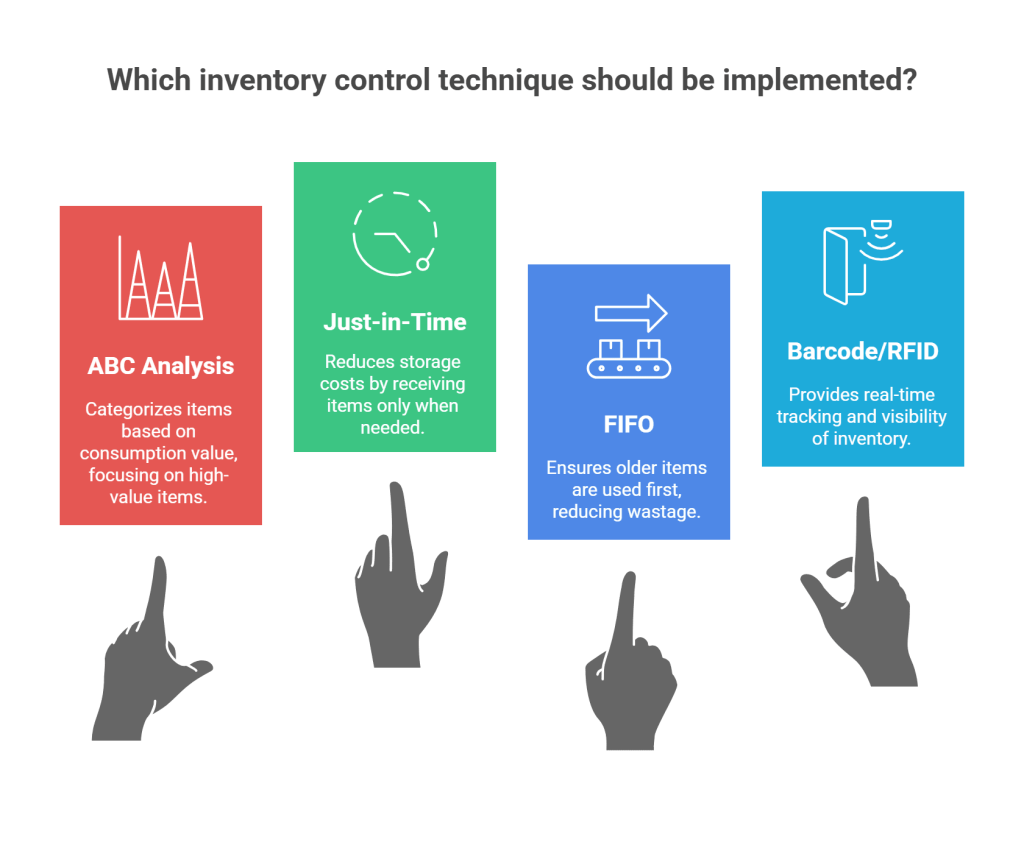
Every second matters in a hospital’s busy hallways. Inventory control techniques in hospital must always be readily available for the smooth and efficient operation of vital medical supplies and life-saving medicines.
Hospitals can now guarantee better patient care as these systems have automated the inventory management process, enabling them to keep track of every in and out.
Are you curious how hospital inventory management systems lead their way in the healthcare industry?
Hospitals now serve as more than just locations for patients to receive treatment; they are hubs for all the services that guarantee the best possible use of their personnel, resources, and equipment. So, let’s explore further about such inventory control in healthcare.
Inventory Control Techniques in Hospital Pharmacy
Inventory Control Definition in Hospital Pharmacy: Inventory control in a hospital pharmacy deals with controlling and tracking the stock items of drugs and medical supplies, and at the same time ensures their availability, minimizes wastage, and reduces the cost of such items. It entails maintaining a rightful stock, tracking usage patterns, and utilizing the ordering and replacement systems wisely.
Hospital Inventory Control Policy and Procedures: Hospitals are typically governed by the equity procedures of inventory control and inputting into them implies processes that govern how inventory is managed. Here, these policies set forth rules for regulating the inventory, for instance, procurement, storage and distribution, and waste disposal, which are in all cases in conformity with the regulatory framework and best practices.
Functions of Inventory Control in Hospital
Following are some functions of inventory control in hospitals. Keep reading!
1. Optimal Inventory Levels
Having the ideal stock level is essential for hospitals because it prevents overstocking or understocking, ensuring sufficient funds for both patients’ needs and maintaining the stock as overstocking will always result in the loss of valuable resources and an increase in expenses. Hospitals can attain a balance that improves patient safety while preventing errors connected with excess stock by examining how supplies are used and implementing prudent ordering and replacement procedures. This ensures that hospitals can carry on with their daily operations while also guaranteeing that patients receive the care that they need at the right moment.
2. Cost Control
Inventory control in hospitals involves a big part of the cost. Using critical thinking and proper planning, healthcare should observe their inventory levels and consumption patterns that will reveal different ways to cut costs and raise productivity. One of the vital strategies is the use of wholesale purchasing discounts which can help to reduce the cost of hospitals in the acquisition of medicines and medical supplies through supplying with bulk buying at affordable prices. Furthermore, by bringing down stockouts and being more efficient with the utilization of inventory, hospitals could get better total costs and reduce waste. By following these cost control steps, hospitals will have greater efficiency in the usage of resources that will not only preserve them but also enable them to be directed in the area of responsibility to patients.
3. Efficient Supply Chain Management
An efficient supply chain is the lifeline of the medical world; that’s why hospitals must have enough medicines and medical equipment. Inventory control plays a crucial part in getting an adequate performance out of a supply chain by detecting damages and applying appropriate fixes. Hospitals broaden their access to a wide range of suppliers, engaging them closely to arrange the optimal price, supply schedule, and product quality.
Another essential element is inventory forecasting, which enables hospitals to project demand and modify inventory levels properly. Hospitals may minimize excess inventory and lower the risk of stockouts by using data and analytics to influence their inventory management decisions.
4. Patient Safety
In the healthcare industry, the safety of patients is the key guide. Inventory control strategy must ensure the availability of these needed pharmaceutical and medical supplies in the market when necessary. The absence of required pharmaceutical supplies might cause much harm to patients with ineffective treatment or inadequate treatment.
Hospitals that adopt stock-out preventive measures and ensure the availability of medicines guarantee patient safety because the right medicines are available at the right time. All these things involve well-organized ordering and stock replenishment procedures besides managing the appropriate amount of inventories based on usage trends.
5. Compliance
The paramount regulations must be made at hospitals for monitoring and allocation of restricted drugs such as those of opioids and some sedatives. Tracking diversion and misuse has to be done as accurately as possible which requires documentation of purchase, consumption, and disposal. To achieve such an aim, medical facilities should have certain storage requirements such as safe and effective pharmaceuticals and medical supplies. To do this, one must ensure the right amount of humidity, light, and temperature and have proper devices to prevent theft and unwanted entry.
Hospitals should also carefully watch and manage supply and medicine expiration dates to avoid using out-of-date items that could be hazardous or ineffective for patients. This entails putting procedures in place for replenishing inventories and eliminating out-of-date commodities. They must also keep precise and current records of all their inventory management operations, including acquisition, use, and disposal. Hospitals must thus set up strong inventory management procedures to guarantee compliance with relevant rules and laws.
Basic Techniques of Inventory Control in Hospital

Efficient inventory control is essential in hospitals to ensure that critical medical supplies are available when needed, reduce wastage, and maintain cost-effective operations. The following are some of the most widely adopted techniques used in hospital inventory management:
1. ABC Analysis
Overview:
ABC Analysis is an inventory categorization technique that divides items into three categories—A, B, and C—based on their consumption value (cost multiplied by usage).
Details:
- Category A: High-value items with low frequency of use. These typically account for about 10–20% of the inventory items but represent 70–80% of the inventory value. Examples include expensive surgical instruments or rare medications.
- Category B: Medium-value items used at a moderate frequency. These represent about 30% of the items and 15–25% of the value.
- Category C: Low-value items that are used frequently. Though they make up around 50–60% of the items, they contribute only 5–10% to the total value.
Benefits:
- Enables focused management of critical high-cost items.
- Helps in budget allocation and policy-making.
- Ensures better financial control of inventory.
2. Just-in-Time (JIT) Inventory Management
Overview:
The JIT method involves purchasing and receiving inventory only when it is needed for immediate use, rather than stocking up in advance.
Details:
- Reduces the need for extensive storage facilities.
- Minimizes the risk of wastage due to expiry, especially for perishable or short-shelf-life items like vaccines or blood products.
- Encourages stronger relationships with reliable suppliers who can deliver on short notice.
Challenges:
- Requires a robust supply chain and precise demand forecasting.
- Vulnerable to disruptions in supply, which can be critical in emergencies.
Best For:
Hospitals looking to reduce inventory carrying costs and waste, especially in non-critical items.
3. First-In, First-Out (FIFO)
Overview:
FIFO is a widely used method that ensures that the oldest inventory items are used first before newer stock is consumed.
Details:
- Particularly important for items with expiry dates such as medicines, surgical gloves, and lab reagents.
- Promotes timely consumption and helps prevent the accumulation of expired or obsolete items.
- Often integrated into automated inventory systems that alert staff to approaching expiry dates.
Implementation:
Stockrooms are organized in a way that older items are more accessible, or stock is arranged by expiry dates to simplify usage.
4. Barcode and RFID Technology
Overview:
Technological solutions like barcodes and Radio Frequency Identification (RFID) systems are increasingly used for accurate tracking and real-time visibility of inventory.
Details:
- Barcodes: Involve scanning printed labels using handheld or fixed scanners. Each scan updates the inventory database.
- RFID Tags: Use embedded chips and wireless signals to track items automatically, often without line-of-sight scanning.
Benefits:
- Real-time inventory updates and alerts on stock levels, expiry dates, and reordering needs.
- Reduces manual errors in inventory counts.
- Speeds up processes in busy hospital environments, from emergency rooms to operating theatres.
Conclusion
To recap, inventory control techniques in hospital are key to the well-managed stocks in hospitals. These methods of hospital supply chain management can ensure the right medicines and equipment to prevent wastage and improve patient care. So, what are you waiting for? Start implementing these strategies soon and do your smart work!
FAQs: The Importance of Inventory Control Techniques in Hospital
1. How important is inventory control in healthcare facilities?
Inventory control is absolutely critical in healthcare. It ensures that life-saving medicines and essential medical supplies are always available when needed. Proper control directly impacts patient safety, treatment outcomes, operational efficiency, and cost management across the entire hospital system.
2. What are the advantages of efficient inventory control for hospitals?
Efficient inventory control helps hospitals cut down on waste, avoid stockouts, and reduce operational costs. It also improves order accuracy, enhances patient care by ensuring timely availability of medicines and equipment, and supports compliance with healthcare regulations.
3. What difficulties do hospitals face when putting inventory control techniques into practice?
Common challenges include managing a wide range of inventory items, integrating inventory systems with other hospital departments, handling data inaccuracies, ensuring staff training, and maintaining compliance with evolving regulations and quality standards.
4. How does inventory control contribute to better patient care?
By maintaining accurate stock levels of essential supplies and medications, hospitals avoid treatment delays or disruptions. This leads to safer, faster, and more reliable care, minimizing the risks of using expired or unavailable products.
5. What role does technology play in hospital inventory control?
Technologies like barcode scanning, RFID, and cloud-based inventory software offer real-time tracking, reduce manual errors, improve visibility, and automate replenishment. These innovations streamline inventory processes and support better decision-making.
6. What is ABC analysis and how is it used in hospitals?
ABC analysis categorizes inventory into three groups: A (high-value, low-quantity), B (moderate-value), and C (low-value, high-quantity). This allows hospitals to prioritize management and oversight based on value and consumption, ensuring critical items are always in stock.
7. How does Just-in-Time (JIT) inventory benefit hospitals?
JIT ensures supplies are ordered and delivered only when needed, reducing overstock and minimizing storage space requirements. It helps hospitals operate leaner, saves money, and limits wastage—especially for items with short shelf lives.
8. Why is First-In, First-Out (FIFO) important in healthcare inventory?
FIFO ensures that the oldest stock is used first, preventing expired products from being used and reducing inventory waste. It’s especially vital for medications, sterile items, and any products with expiry dates.
9. How does inventory control support regulatory compliance?
Hospitals must meet strict legal requirements regarding drug storage, usage, and tracking—especially for controlled substances. Good inventory control ensures accurate documentation, proper environmental storage conditions, and timely removal of expired stock to stay compliant.
10. What can hospitals do to improve their inventory management today?
Hospitals can start by implementing automated inventory systems, training staff in best practices, standardizing processes like FIFO and ABC analysis, and regularly auditing stock levels. Collaborating with trusted suppliers and using data analytics for demand forecasting are also game-changers.






